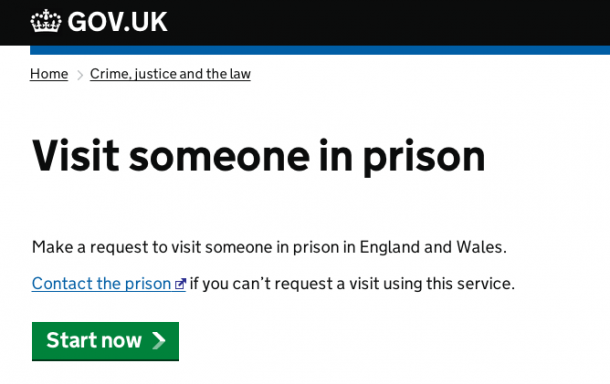Recently, Ministry of Justice Digital Services made it possible to book a prison visit online. Nicole Kobilansky from the Ministry of Justice explains a bit more about the process of making sure everyone is able to access this service.
Before the new prison visit booking service launched, the only way to book a prison visit would be by receiving a Visiting Order Form from the prisoner, and then calling the prison to arrange a date and time. Seems simple enough, however the reality is that prison phone lines, which are only open for a number of hours each week, are usually so busy that getting through ends up taking days if not weeks – and results in wasted credit and immeasurable frustration.
We hoped our online request service would be an elegant solution, allowing visitors to submit requests on a desktop or mobile, any time of day, via a 5-minute transaction. However, we recognised that some people would need support using this solution.
Researching users
During the development of the online request service, we visited the Borough charity Prisoner Friends and Families. In a morning support group, we realised some of our users had trouble with understanding the digital tool. This included problems with language, literacy or even getting access to a computer.
We needed to do more research to understand exactly how many visitors would be able to use our digital service independently, and how many would require support to book a visit.
To do this we ran a 6-week phone survey on the prison booking lines. This included phone lines at local prisons (Durham, Cardiff, Aylesbury, Holloway and Pentonville) and also 1 contact centre (which covers 8 prisons in the Midlands).
At each research site the call handlers were trained to:
- direct users to the online request service
- ask users questions to identify their barriers to using the online request service
- guide a less confident user through the online request service
The survey also collected details of user satisfaction and call-wait times. Because prisons are busy and hectic places, the call handlers were provided with simple box-ticking templates for noting down calls.

Prison staff weren’t too keen on prolonging the phone calls on very busy phone lines. So, in some of the locations, in-person surveys with a clipboard had to be carried out instead.
What we found out
In total 2,248 users were surveyed. The results indicated there is potential for around 80% of callers to shift to the digital channel within the next year. 6% of users are likely to have digital inclusion needs, and 14% of users are likely to have assisted digital needs.

All the hard work paid off. We used this data to design an assisted digital service for the 20% of users who have difficulty using the digital service. When users call to book a visit, they’re first taken through a quick needs assessment to understand why they can’t use the digital service. This assessment gives information to the call handlers to help them guide callers in the best way.
If the caller has access to a computer or smartphone at that moment in their home, they can be talked through the online booking process to learn how to use it. If the caller doesn’t have any access, the call handler can book a visit for them straight away. The data from the survey also helped to understand how we can influence callers to shift to the digital channel.
Call handlers across the 95 prisons are now using this model. Insight into the service shows 40% of people are shifting to use the digital channel. Previously busy phone lines are beginning to free up which means people who are able to access the internet can book visits quickly and conveniently. Also callers with genuine needs for assistance are being transitioned into a truly assisted digital service over the phone which also helps them learn how to use the digital service next time.
We’re hoping to run a survey of callers every 6 months across all prisons so that we can continue to improve all the services.
Don’t forget to sign up for assisted digital email alerts
